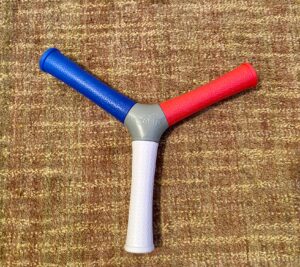Brian Schiff’s Blog
Injury Prevention, Sports Rehab & Performance Training Expert
Over the years, I have tested many different fitness products through my work with Personal Fitness Professional Magazine. I am not paid to promote any products on my site, and this latest review comes after spending the past few weeks using this particular product in the clinic with my patients. I am pleased to bring attention to it because I think it can help with recovery and training.
Recently, the inventor of the HECOstix, Josh Broeker, reached out to me to see if I have had a chance to use his product. Much to my surprise, I was not familiar with it. As a performance physical therapist working with many athletes from various sports and ranging from youth to professionals, I was naturally excited to see the product in action. I am always looking for ways to enhance neurocognitive training and my rehab. Josh was gracious enough to send me a few HECOstix to try out.
For those unfamiliar with the product, see the image of the Red, White and Blue version below:

As I rehab and progress athletes back to sport after injury, implementing tools to improve hand eye coordination, reaction time, cognitive skills and decision making is important prior to sending them back to practice and sport. A few of the really cool features I like about this product include:
- Lightweight and durable EVA make-up
- Different versions and multiple colors allow for auditory cues and quick reaction
- It can be used safely by all ages and abilities
- Travels easily with you anywhere
The HECOstix can be used for virtually any sport and done indoors or outdoors. Perhaps the greatest thing about the product is that it injects FUN into training while allowing users to compete against others or their own results in an effort to improve performance. This tool also allows for progressive challenges moving from underhand to sideways to overhead throws depending on the functional demands and skill level of the participants.
In the clinic, I have been using it with some of my patients rehabbing after ACL reconstruction. Adding neurocognitive training is essential for full recovery and secondary prevention. below is an article from Sports health discussing neurocognitive and neurophysiological functions related to ACL injury:
https://pubmed.ncbi.nlm.nih.gov/34236003/
Specifically, I have integrated it with dynamic balance and movement drills calling out a color while throwing the HECOstix toward the client. I have also had a pair of patients throwing and calling out the color as part of a rehab game. I will be continuing to use it with this population and other athletes working on hand eye coordination and cognitive training for their sport.
If you are looking to add a new wrinkle to your training or rehab, I highly recommend giving this product a try. For more information on the product, be sure to visit www.hecostix.com.
One of the great things about being a columnist for PFP Magazine is that I often get to test out the latest fitness equipment on the market. While there are certainly some very gimmicky things out there, I have some ‘go to’ selections in my toolbox, such as the BOSU®NexGen™Pro Balance Trainer. It is the latest version of this training tool.
In my clinic, I rehab lots of athletes suffering from gluteus medius weakness, poor pillar stability and decreased hip stability. Many of my clientele are working to make it back from ACL reconstruction. One of my preferred strengthening exercises to target the shoulder, torso and hips is split squats. Once the client masters proper form on the ground, I move to an unstable setting using the BOSU®.
It is essential to challenge athletes to avoid valgus collapse. The BOSU® introduces instability at the ankle forcing the body to adapt during the split squat movement. Avoiding dynamic valgus and trunk dominance during training will help with injury reduction efforts for the client.
In the video below I produced for my PFP online column, you will see how to use this exercise effectively to improve strength, stability and proprioception.
Poor landing mechanics are often cited as a predictor of ACL injury risk. In my 20 years as a physical therapist, I have rehabbed many athletes with this injury. I believe that injury prevention, whether to prevent a primary or secondary injury, hinges on the ability to train the body to decelerate and land appropriately. Some athletes simply move better than others. Nonetheless, teaching a soft bent knee landing while minimizing dynamic valgus is essential.
The following video from my online PFP column reveals a foundational exercise that can be used in prevention and rehab alike.
Click here if you want to read about another landing exercise that I utilize in my training and rehab programs.
Unfortunately, I see far too many patients following ACL reconstruction in my sports medicine practice. In any given month, I am rehabbing between 10 and 15 patients who have lost their season to this injury. Most of the time it is a non-contact mechanism of injury, often involving additional trauma to the collateral ligaments, menisci and/or cartilage within the joint.
Throughout my career, I have rehabbed several hundred athletes with ACL tears. It has always been an area of interest and passion for me as well as prevention. Blending my background in performance training with rehab, I have fostered through much trial and adjustment what seems to be a very effective approach to rehab and return to sport. Rehabbing higher level athletes is much like working on a high performance sports cars.
If you own a high performance vehicle, you would prefer to have it serviced at a dealership where the mechanics are experienced working on similar cars, yes? I feel the same care and application is relevant with ACL rehab. PT that is too aggressive or too conservative can impede progress and negatively impact peak performance.
Why is it that athletes performing a movement they have done so many times suddenly tear their ACL? We have been studying ACL injury and prevention for many years now, and despite our best efforts, we have not made marked progress in preventing the number of ACL injuries. In addition to anatomical variants and perhaps some genetic predisposition, I feel that the earlier push for sports specialization in our society resulting in increased training/competition hours is a major factor.
The term ACL fatigue may or may not be familiar to you. But in essence, this theory would suggest that after a certain number of impacts/loading, the ACL becomes weakened and less resistant to strain. You could almost compare this to a pitcher who suffers an injury to his medial collateral ligament with too much throwing.
As someone who is consistently rehabbing athletes with ACL tears and screening athletes to assess injury risk, I am always interested in how we can keep people from suffering such a devastating non-contact injury. A recent article in the American Journal of Sports Medicine sought so assess ACL fatigue failure in relation to limited hip internal rotation with repeated pivot landings.
We already know that hip mobility is often an issue for our athletes. Researchers at the University of Michigan sought to determine the effect of limited range of femoral internal rotation, sex, femoral-ACL attachment angle, and tibial eminence volume on in vitro ACL fatigue life during repetitive simulated single leg pivot landings.



